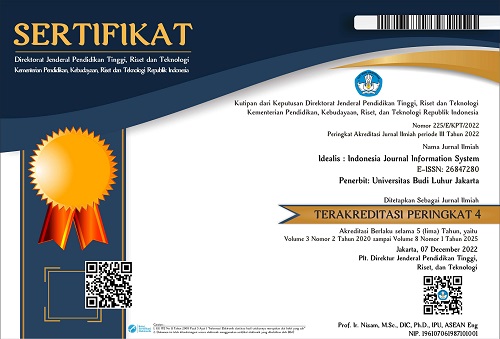PENERAPAN MODEL CRISP-DM PADA PREDIKSI NASABAH KREDIT MENGGUNAKAN ALGORITMA RANDOM FOREST
DOI:
https://doi.org/10.36080/idealis.v7i2.3244Keywords:
Savings and Loan Cooperative, Non-Performing Loans, Machine Learning, Credit Prediction, Random ForestAbstract
Non-performing loans (NPLs) are one of the main challenges faced by Baitut Tamwil Tazakka Savings and Loan Cooperative, which can potentially threaten the financial stability and health of the institution. This study aims to evaluate the effectiveness of the Random Forest algorithm in predicting NPLs in the cooperative. The CRISP-DM method is applied in this study, encompassing the stages of business understanding, data understanding, data preparation, modeling, evaluation, and deployment. The data used consists of 14 attributes and 190 records that have been cleaned of missing values. The modeling results show that the Random Forest algorithm can provide very high prediction accuracy, with the best accuracy reaching 94.8% on a 90:10 dataset split. Performance metrics evaluation such as AUC, CA, F1 Score, Precision, Recall, and MCC indicate very good values, signifying strong predictive performance. Confusion matrix analysis also confirms high prediction accuracy with most correct predictions in the categories of non-performing, performing, and sub-performing loans. This study confirms that the Random Forest algorithm is effective in predicting NPLs, underscores the importance of applying machine learning in credit risk management, and contributes significantly to the financial stability of the cooperative through more accurate NPL predictions.
Downloads
References
[2] E. Wahyu and H. Budianto, “Bank Bukopin Syariah dan Konvensional: Studi Pustaka (Library Research) dan Bibliometrik VOSviewer,” 2023, doi: 10.5281/zenodo.10049572.
[3] J. Sanjaya, E. Renata, V. E. Budiman, F. Anderson, and M. Ayub, “Prediksi Kelalaian Pinjaman Bank Menggunakan Random Forest dan Adaptive Boosting,” Jurnal Teknik Informatika dan Sistem Informasi, vol. 6, no. 1, Apr. 2020, doi: 10.28932/jutisi.v6i1.2313.
[4] S. N. Luqman et al., “Komparasi Algoritma Klasifikasi Genre Musik pada Spotify Menggunakan CRISP-DM,” 2021.
[5] O. Pahlevi and Y. Handrianto, “Implementasi Algoritma Klasifikasi Random Forest Untuk Penilaian Kelayakan Kredit,” Jurnal Infortech, vol. 5, no. 1, 2023, [Online]. Available: http://ejournal.bsi.ac.id/ejurnal/index.php/infortech
[6] H. Indrawan, B. Irawan, and T. Suprapti, “KLASIFIKASI ULASAN PENGGUNA APLIKASI ACCESS BY KAI BERBASIS ASPEK DENGAN ALGORITMA NAÏVE BAYES DAN SVM,” 2023.
[7] C. Cahyaningtyas, D. Manongga, and I. Sembiring, “ALGORITHM COMPARISON AND FEATURE SELECTION FOR CLASSIFICATION OF BROILER CHICKEN HARVEST,” Jurnal Teknik Informatika (Jutif), vol. 3, no. 6, pp. 1717–1727, Dec. 2022, doi: 10.20884/1.jutif.2022.3.6.493.
[8] A. B. Prasetyo and T. G. Laksana, “Optimasi Algoritma K-Nearest Neighbors dengan Teknik Cross Validation Dengan Streamlit (Studi Data: Penyakit Diabetes),” 2022. [Online]. Available: http://jurnal.polibatam.ac.id/index.php/JAIC
[9] N. Hasdyna and R. Kesuma Dinata, “Analisis Matthew Correlation Coefficient pada K-Nearest Neighbor dalam Klasifikasi Ikan Hias,” 2020.
[10] N. Khoirunnisaa, K. Nabila, N. Kesuma, S. Setiawan, A. Yunizar, and P. Yusuf, “Klasifikasi Teks Ulasan Aplikasi Netflix Pada Google Play Store Menggunakan Algoritma Naive Bayes dan SVM,” SKANIKA: Sistem Komputer dan Teknik Informatika, vol. 7, no. 1, pp. 64–73, 2024.
[11] T. H. Hasibuan and D. Mahdiana, “Prediksi Kelulusan Mahasiswa Tepat Waktu Menggunakan Algoritma C4.5 Pada Uin Syarif Hidayatullah Jakarta,” SKANIKA: Sistem Komputer dan Teknik Informatika, vol. 6, pp. 61–74.
[12] Intan Permata and Esther Sorta Mauli Nababan, “Application Of Game Theory In Determining Optimum Marketing Strategy In Marketplace,” JURNAL RISET RUMPUN MATEMATIKA DAN ILMU PENGETAHUAN ALAM, vol. 2, no. 2, pp. 65–71, Jul. 2023, doi: 10.55606/jurrimipa.v2i2.1336.
[13] A. Citra Mawani, L. Li Hin, and D. Anubhakti, “DETEKSI DINI GEJALA AWAL PENYAKIT DIABETES MENGGUNAKAN ALGORITMA RANDOM FOREST,” 2023. [Online]. Available: http://jom.fti.budiluhur.ac.id/index.php/IDEALIS/indexAjengCitraMawani|http://jom.fti.budiluhur.ac.id/index.php/IDEALIS/index|
[14] R. Rizqi Robbi Arisandi, B. Warsito, and A. Rachman Hakim, “APLIKASI NAÏVE BAYES CLASSIFIER (NBC) PADA KLASIFIKASI STATUS GIZI BALITA STUNTING DENGAN PENGUJIAN K-FOLD CROSS VALIDATION,” JURNAL GAUSSIAN, vol. 11, no. 1, pp. 130–139, 2022, [Online]. Available: https://ejournal3.undip.ac.id/index.php/gaussian/
[15] E. Budiawan and M. Tryana Sembiring, “UTILIZING SCIENCE DATA TO INCREASING THE NUMBER MSME DEBTORS AT PT.BANK CENTRAL ASIA.TBK (CASE STUDY OF PT. BANK CENTRAL ASIA.TBK KCU TEBING TINGGI),” Journal of Accounting Research, Utility Finance and Digital Assets, vol. 2, 2023, [Online]. Available: https://jaruda.org




.png)














